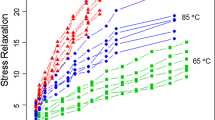Abstract
Constant stress accelerated degradation tests (CSADT) are widely used in life perdition for highly reliable products to infer the lifetime distribution under operating conditions. Optimal design of an CSADT can improve life prediction accuracy and reduce test costs significantly. In the literature of CSADT design, most approaches focus on how to determine the sample allocation scheme, inspection frequency and test duration, but the issue of how to optimize the stress levels is seldom considered. In this work, we propose a novel method to optimize the CSADT considering both stress levels selection and samples allocation. First, an accelerated degradation model based on the Wiener process is used to model the degradation data. Next, under the constraint of sample size, a local-search based iterative algorithm is proposed to optimize parameters including stress levels and sample number under each level so as to obtain an accurate estimate of the distribution statistics. Finally, a case study of lithium-ion batteries is presented to validate the proposed method.




Similar content being viewed by others
References
Ye, Z.S., Xie, M.: Stochastic modelling and analysis of degradation for highly reliable products. Appl. Stoch. Mod. Bus. Ind. 31(1), 16–32 (2015)
Freitas, M.A., Maria, L.G., Enrico, A., et al.: Using degradation data to assess reliability: a case study on train wheel degradation. Qual. Reliab. Eng. Int. 25, 607–629 (2009)
Weaver, B.P., Meeker, W.Q., Escobarc, L.A., et al.: Methods for planning repeated measures degradation. Technometrics 55(2), 122–134 (2013)
Sun, Q., Tang, Y., Feng, J., et al.: Reliability assessment of metallized film capacitors using reduced degradation test sample. Qual. Reliab. Eng. Int. 29(2), 259–265 (2012)
Weaver, B.P., Meeker, W.Q.: Methods for planning repeated measures accelerated degradation tests. Appl. Stoch. Mod. Bus. Ind. 30(6), 658–671 (2014)
Li, H., Pan, D.H., Chen, C.L.P.: Reliability modeling and life estimation using an expectation maximization based wiener degradation model for momentum wheels. IEEE Trans. Cybern. 45(5), 955–963 (2015)
Ye, Z.S., Xie, M., Tang, L.C., et al.: Efficient semiparametric estimation of gamma processes for deteriorating products. Technometrics 56(4), 504–513 (2014)
Wu, S.J., Chang, C.T.: Optimal design of degradation tests in presence of cost constraint. Reliab. Eng. Syst. Saf. 76(2), 109–115 (2002)
Marseguerra, M., Zio, E., Cipollone, M.: Designing optimal degradation tests via multi-objective genetic algorithms. Reliab. Eng. Syst. Saf. 79(1), 87–94 (2003)
Boulanger, M., Escobar, L.A.: Experimental design for a class of accelerated degradation tests. Technometrics 36, 260–272 (1994)
Sung, S.I., Yum, B.J.: Optimal design of step-stress accelerated degradation tests based on the Wiener degradation process. Qual. Technol. Quant. Manag. 13, 367–393 (2016)
John, W., Justin, P., Ping, L., et al.: Degradation of lithium ion batteries employing graphite negatives and nickel-cobalt-manganese oxide + spinel manganese oxide positives: part 1, aging mechanisms and life estimation. J. Power Sources 269, 937–948 (2014)
Park, C., Padgett, W.J.: Stochastic degradation models with several accelerating variables. IEEE Trans. Reliab. 55(2), 379–390 (2006)
Wang, X.L., Balakrishnan, N., Guo, B.: Residual life estimation based on a generalized wiener degradation process. Reliab. Eng. Syst. Saf. 124, 13–23 (2014)
Whitmore, G.A., Schenkelberg, F.: Modeling accelerated degradation data using Wiener diffusion with a time scale transformation. Lifetime Data Anal. 3(1), 27–45 (1997)
Liu, T.Y., Sun, Q., Pan, Z.Q., et al.: Irregular time-varying stress degradation path modeling: a case study on lithium ion cell degradation. Qual. Reliab. Eng. Int. 32(5), 1889–1902 (2015)
Liu, T., Sun, Q., Feng, J., et al.: Residual life estimation under time-varying conditions based on a Wiener process. J. Stat. Comput. Simul. 87, 211–226 (2016)
Acknowledgements
Funding was provided by National Natural Science Foundation of China (Grant Nos. 71472174, 61533019, 71232006, 61233001) and also Hunan Natural Science Foundation of China (Grant No. 2017JJ336).
Author information
Authors and Affiliations
Corresponding author
Ethics declarations
Conflict of interest
The authors declare that there is no conflict of interests regarding the publication of this paper.
Rights and permissions
About this article
Cite this article
Shen, D., Liu, T., Zhang, L. et al. A novel accelerated degradation test design considering stress optimization. Cluster Comput 22 (Suppl 4), 8793–8802 (2019). https://doi.org/10.1007/s10586-018-1970-0
Received:
Revised:
Accepted:
Published:
Issue Date:
DOI: https://doi.org/10.1007/s10586-018-1970-0




